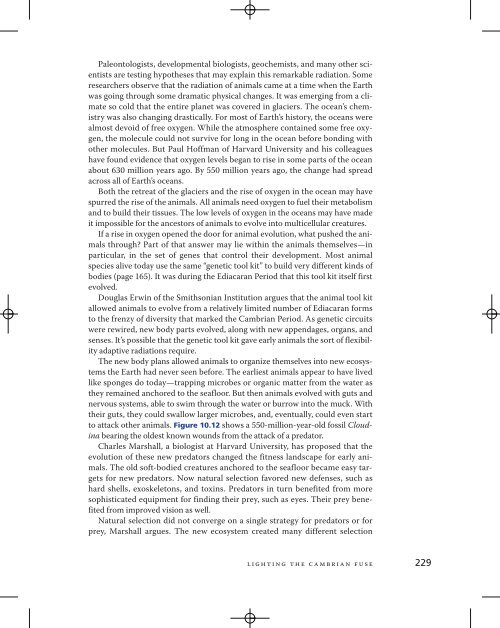Reprinted from The Tangled Bank: An Introduction to Evolution by ...
Reprinted from The Tangled Bank: An Introduction to Evolution by ...
Reprinted from The Tangled Bank: An Introduction to Evolution by ...
You also want an ePaper? Increase the reach of your titles
YUMPU automatically turns print PDFs into web optimized ePapers that Google loves.
Paleon<strong>to</strong>logists, developmental biologists, geochemists, and many other scientists<br />
are testing hypotheses that may explain this remarkable radiation. Some<br />
researchers observe that the radiation of animals came at a time when the Earth<br />
was going through some dramatic physical changes. It was emerging <strong>from</strong> a climate<br />
so cold that the entire planet was covered in glaciers. <strong>The</strong> ocean’s chemistry<br />
was also changing drastically. For most of Earth’s his<strong>to</strong>ry, the oceans were<br />
almost devoid of free oxygen. While the atmosphere contained some free oxygen,<br />
the molecule could not survive for long in the ocean before bonding with<br />
other molecules. But Paul Hoffman of Harvard University and his colleagues<br />
have found evidence that oxygen levels began <strong>to</strong> rise in some parts of the ocean<br />
about 630 million years ago. By 550 million years ago, the change had spread<br />
across all of Earth’s oceans.<br />
Both the retreat of the glaciers and the rise of oxygen in the ocean may have<br />
spurred the rise of the animals. All animals need oxygen <strong>to</strong> fuel their metabolism<br />
and <strong>to</strong> build their tissues. <strong>The</strong> low levels of oxygen in the oceans may have made<br />
it impossible for the ances<strong>to</strong>rs of animals <strong>to</strong> evolve in<strong>to</strong> multicellular creatures.<br />
If a rise in oxygen opened the door for animal evolution, what pushed the animals<br />
through? Part of that answer may lie within the animals themselves—in<br />
particular, in the set of genes that control their development. Most animal<br />
species alive <strong>to</strong>day use the same “genetic <strong>to</strong>ol kit” <strong>to</strong> build very different kinds of<br />
bodies (page 165). It was during the Ediacaran Period that this <strong>to</strong>ol kit itself first<br />
evolved.<br />
Douglas Erwin of the Smithsonian Institution argues that the animal <strong>to</strong>ol kit<br />
allowed animals <strong>to</strong> evolve <strong>from</strong> a relatively limited number of Ediacaran forms<br />
<strong>to</strong> the frenzy of diversity that marked the Cambrian Period. As genetic circuits<br />
were rewired, new body parts evolved, along with new appendages, organs, and<br />
senses. It’s possible that the genetic <strong>to</strong>ol kit gave early animals the sort of flexibility<br />
adaptive radiations require.<br />
<strong>The</strong> new body plans allowed animals <strong>to</strong> organize themselves in<strong>to</strong> new ecosystems<br />
the Earth had never seen before. <strong>The</strong> earliest animals appear <strong>to</strong> have lived<br />
like sponges do <strong>to</strong>day—trapping microbes or organic matter <strong>from</strong> the water as<br />
they remained anchored <strong>to</strong> the seafloor. But then animals evolved with guts and<br />
nervous systems, able <strong>to</strong> swim through the water or burrow in<strong>to</strong> the muck. With<br />
their guts, they could swallow larger microbes, and, eventually, could even start<br />
<strong>to</strong> attack other animals. Figure 10.12 shows a 550-million-year-old fossil Cloudina<br />
bearing the oldest known wounds <strong>from</strong> the attack of a preda<strong>to</strong>r.<br />
Charles Marshall, a biologist at Harvard University, has proposed that the<br />
evolution of these new preda<strong>to</strong>rs changed the fitness landscape for early animals.<br />
<strong>The</strong> old soft-bodied creatures anchored <strong>to</strong> the seafloor became easy targets<br />
for new preda<strong>to</strong>rs. Now natural selection favored new defenses, such as<br />
hard shells, exoskele<strong>to</strong>ns, and <strong>to</strong>xins. Preda<strong>to</strong>rs in turn benefited <strong>from</strong> more<br />
sophisticated equipment for finding their prey, such as eyes. <strong>The</strong>ir prey benefited<br />
<strong>from</strong> improved vision as well.<br />
Natural selection did not converge on a single strategy for preda<strong>to</strong>rs or for<br />
prey, Marshall argues. <strong>The</strong> new ecosystem created many different selection<br />
lighting the cambrian fuse 229

















